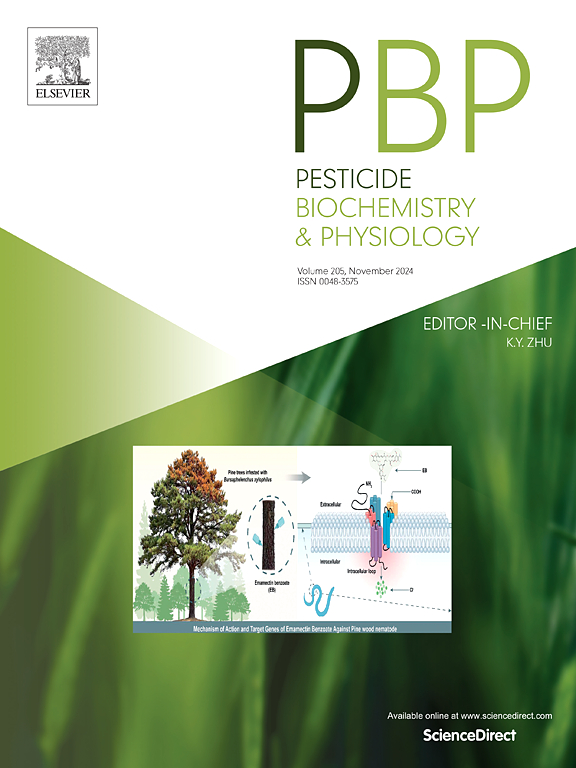基于rna序列的褐飞虱吡虫啉耐药机制鉴定及CYP6ER1变异诊断工具的开发
IF 4.2
1区 农林科学
Q2 BIOCHEMISTRY & MOLECULAR BIOLOGY
引用次数: 0
摘要
新烟碱类杀虫剂,如吡虫啉,已经使用了30多年,用于控制主要的农业害虫,包括褐飞虱(Nilaparvata lugens)、蚜虫和其他食液昆虫。然而,吡虫啉的广泛使用导致亚洲许多害虫种群普遍产生抗药性。生物测定结果表明,绿僵菌具有明显的抗性,抗性比为32。RNA-seq分析显示,解毒酶基因的过表达在抗性中起核心作用,其中CYP6ER1是最显著上调的基因,抗性菌株比敏感菌株增加28倍。在解毒酶中,羧酸酯酶和谷胱甘肽-s转移酶表现出轻微的抗性特异性过表达,而其他酶则保持不变。迄今为止,已经报道了CYP6ER1的六种主要变异。在目前的研究中,CYP6ER1vA已被确定为所有耐药菌株、2024年收集的田间种群和1975年的博物馆样本的主要变异。这表明vA变异早于吡虫啉的广泛使用,并且其表达水平,而不仅仅是其存在,是驱动抗性的关键因素。建立了LAMP-PCR检测CYP6ER1vA的诊断方法,为现场耐药性监测提供了一种快速可靠的工具。这些研究结果支持了褐家蝇对吡虫啉的系统性抗性管理,将分子诊断与可持续虫害防治策略相结合。本文章由计算机程序翻译,如有差异,请以英文原文为准。

RNA-seq-based identification of imidacloprid resistance mechanisms in Nilaparvata lugens and development of diagnostic tools for the CYP6ER1 variant
Neonicotinoid insecticides, such as imidacloprid, have been used for over three decades to control major agricultural pests, including brown planthopper (Nilaparvata lugens), aphids, and other sap-feeding insects. However, the extensive use of imidacloprid has led to widespread resistance across Asia in many pest populations. Bioassay results demonstrated significant resistance in N. lugens, with a resistance ratio of 32. RNA-seq analysis revealed that the overexpression of detoxification enzyme genes plays a central role in resistance, with CYP6ER1 being the most significantly upregulated gene, showing a 28-fold increase in resistant strain compared to susceptible strain. Among detoxification enzymes, carboxylesterases and glutathione-S-transferases exhibited slightly resistance-specific overexpression, while others remained unchanged. To date, six main variants of CYP6ER1 have been reported. In the current study, CYP6ER1vA has been identified as the predominant variant across all resistant strains, field populations collected in 2024, and museum samples from 1975. This suggests that the vA variant predated the widespread use of imidacloprid and that its expression level, rather than its mere presence, is the key factor driving resistance. A LAMP-PCR diagnostic method was developed to detect CYP6ER1vA, offering a rapid and reliable tool for field-based resistance monitoring. These findings support systematic imidacloprid resistance management in N. lugens, integrating molecular diagnostic with sustainable pest control strategies.
求助全文
通过发布文献求助,成功后即可免费获取论文全文。
去求助
来源期刊
CiteScore
7.00
自引率
8.50%
发文量
238
审稿时长
4.2 months
期刊介绍:
Pesticide Biochemistry and Physiology publishes original scientific articles pertaining to the mode of action of plant protection agents such as insecticides, fungicides, herbicides, and similar compounds, including nonlethal pest control agents, biosynthesis of pheromones, hormones, and plant resistance agents. Manuscripts may include a biochemical, physiological, or molecular study for an understanding of comparative toxicology or selective toxicity of both target and nontarget organisms. Particular interest will be given to studies on the molecular biology of pest control, toxicology, and pesticide resistance.
Research Areas Emphasized Include the Biochemistry and Physiology of:
• Comparative toxicity
• Mode of action
• Pathophysiology
• Plant growth regulators
• Resistance
• Other effects of pesticides on both parasites and hosts.

 求助内容:
求助内容: 应助结果提醒方式:
应助结果提醒方式:


